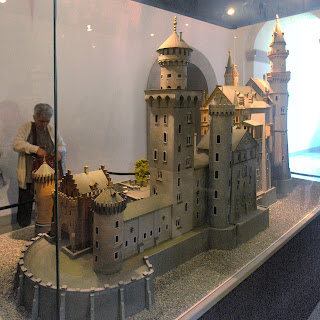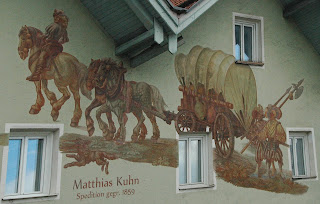We drove the few kilometres into Füssen and beyond, to Schloß Neuschwanstein. This is the castle built by "Mad King Ludwig", Ludwig II of Bavaria, high above his father's Schloß Hohenschwangau. Ludwig was caught up with the medieval concept of the divine right of kings, and was out of touch with the newer parliamentary concepts that had swept through Europe in his time. This was his undoing — he was not "Mad King Ludwig", but just King Ludwig, whose opponents found a way to have him declared mad rather than going through the long process of unseating a king.
Neuschwanstein, although never finished, has interior decoration representing the operas of Richard Wagner, by which Ludwig was particularly impressed. Ludwig's backing allowed Wagner the time and space to write his masterpiece, Das Ring des Nibelungen. Rooms in the castle are decorated with motifs — perhaps one shouldn't say 'Leitmotifen' — from the operas Lohengrin, Tannhauser, Tristan und Isolde, and from Das Ring des Nibelungen, and Parzifal.
The 'Singers' Hall', which Warren expected to be modelled about the Hall from Die Meistersinger von Nürnberg, is instead based on the banqueting hall of the Wartburg as well as the Singers' Hall there.
Although Neuschwanstein was designed in a medieval style, it was equipped with the latest technology of the day.
By the way, the whole theme of Schloß Neuschwanstein is the swan, a central theme in Lohengrin, where the Grailknight (Lohengrin) comes up the river in a barge drawn by a snow-white swan to defend the princess Elsa in trial by combat against a charge of murder. There are hundreds of images of swans throughout the castle. Schloß Neuschwanstein was used by Walt Disney as the model for his Sleeping Beauty Castle in Disneyland.
From the balcony outside the royal apartments there is the most superb view across to Schloß Hohenschwangau — previously known as Schloß Schwanstein — and the nearby lake, Lake Starnberg, in which Ludwig and the head of the psychiatric panel that had declared him insane only three days previously, Dr Gudden, were both found drowned, on 13 June 1886, under most suspicious circumstances. Even today the real story has not come out, but you can make reasoned judgements for yourself!
After exploring the castle, we treated ourselves to a horse-drawn trip down the hill — in the company of some rather garrulous Canadians (somewhat unusual for the species!).
We got back to the van to find another van snuggling up to her — the other vehicles really love Gertie! This time it was a honeymooning couple from the UK.
We drove out, passing some rather spectacular wall painting in Fûssen, and being treated to another striking sky and sun display as we travelled.
We came to a rest stop and pulled up there, having a sense of déja vu — it turned out that it was the opposite side (towards Ulm) of the spot we stopped last night. Needless to say, we had a very quite comfortable night!
Distance driven — today, 41 miles ( 66 km ); to date, 27,646 miles ( 44,492 km )






























I'd say the shrink declared Ludwig sane and they were both executed. We can thank him for giving Wagner house room for the Niebelungen anyway Truly not leit as you say Warren.. Gertie's travels has to be a book. She is a lovely little home away from. The light effects opportunities you've had throughout are truly beautiful. The many interesting and different people tou've seen and met are too. That truck with it's load of wood was well laden! I enjoyed the packaging museum. Was Persil a German product? I remember it as a kid,. Did it change its name after das Reich? Bits and pieces of your scenery look like Heidi country with cows not goats. The mountain top with the outline of the sleeping woman at top is beautiful too. Well must get on with an email for Warren, Take care and our lovew to you, Cathy.
ReplyDelete